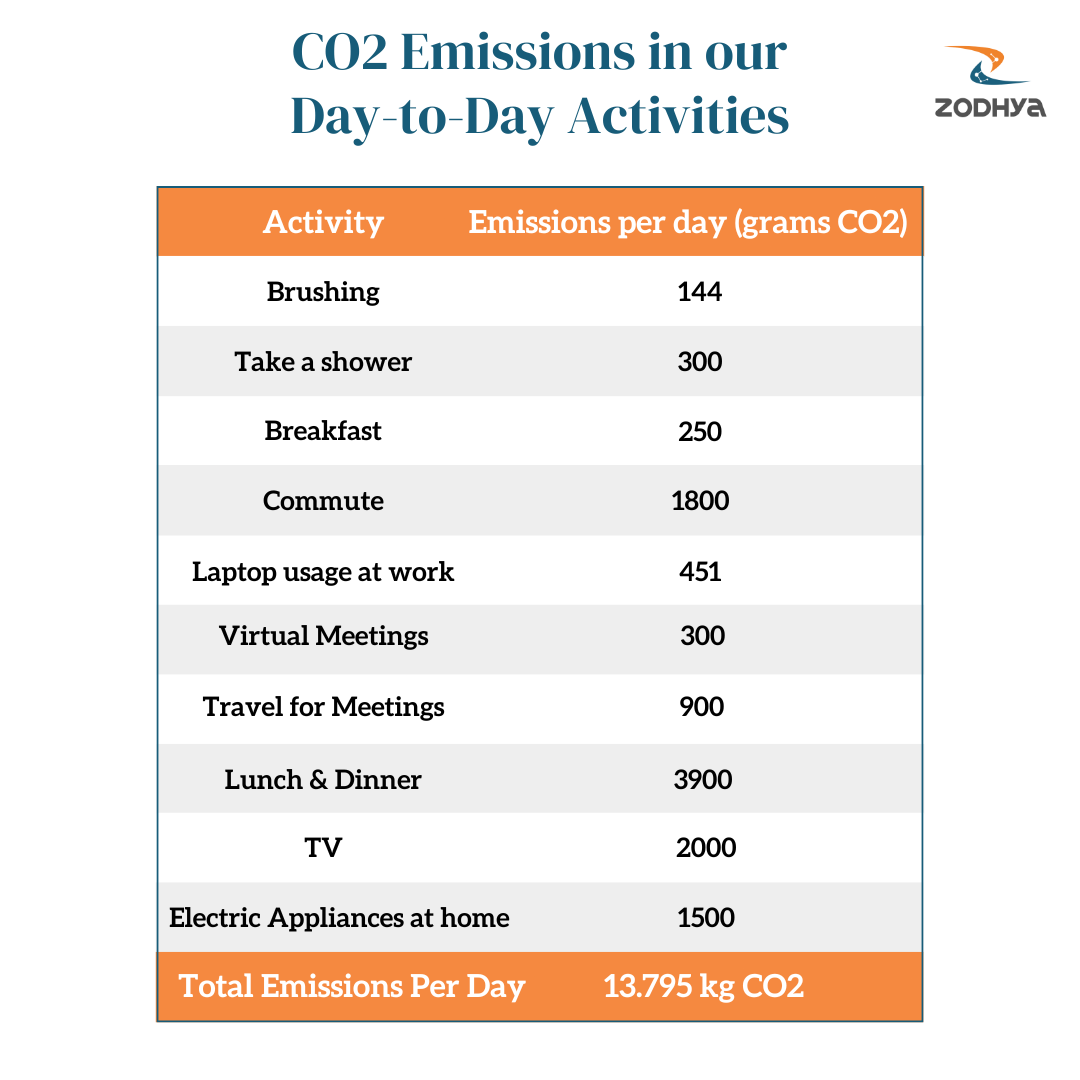We often associate emissions with an industry emitting gases into the atmosphere or a car running on petrol/gasoline emitting a gush of pollutants. But as our activities dictate, there are a lot more emissions we do unknowingly which leads to polluting the planet.
In this blog, let’s try to estimate how many kgs of CO2 we emit in one day. In other words, what is your carbon footprint for a given day? To do this, let's list activities we do from waking up to going to bed and calculate the corresponding emissions for each activity.
Brushing teeth — Brushing teeth involves two major constituents, toothbrush and toothpaste. Toothbrush has a reported emission of 25.6 kg CO2 if it’s a plastic one. Assuming you use it for 6 months, the average per day emission of toothbrush would be 140g CO2. For toothpaste, it is 0.08kg per tube. Assuming you use 5% of it every day, it would be 4g CO2. So, the total emission while brushing would be approximately 144g CO2.
Taking a shower — This depends on the kind of shower you are having and whether you use a gas boiler or an electric heater for hot water. An estimate by BBVA tells an individual emits about 109kg CO2 emission per year during showers. That would translate to nearly 300g of CO2 emission per day for a bath.
Breakfast — This again depends on what you consume during breakfast. Is it milk, traditional food, English breakfast, quick grab-and-eat, veg or non-veg? So many options, ah! It is estimated that the emission would vary between 1300g-3800g CO2 per breakfast meal. On average, for our calculation here, let’s assume it to be 2500g CO2e.
Commute (~10km) — Now comes the next part wherein you travel, either to your office or college. Even here, the medium of transport plays a role. It could be public transport or a two-wheeler or a four-wheeler.
The emission of a bus could be 515g CO2e per km, it could carry on average 50 passengers, thus bringing down the emissions to 10.3 g/km.
Meanwhile, the emission for a petrol-run car could be 170g CO2 emissions per km.
Here again, since we are looking to arrive at an estimate for average emissions per day for an individual, let’s assume it to be 90g CO2e per km.
For a daily transport of 10km to and fro (20km in total), it would be 1800g of CO2 emissions for commute related emissions per day.
Work — Emissions during work depend on the type of work the individual is into. Here, we assume the individual works about 3 hours on screen (either phone/ laptop), takes online meetings for 30 minutes, and travels to meet people for work-related activities (about 5km on average).
For this, the emissions would translate to —
Laptop — Emission during production — 331kg CO2. Assuming it lasts 3 years, the emission per day would be 300g CO2.
Emission during usage — Laptops on average are rated at 70W, which translates to an energy consumption of 0.21 units per day. In India, the emission per unit (2023) is 0.72 kg per unit. This means the emission of a laptop during usage per day is 151g CO2 per day.
The total emission of the laptop during usage would be 300+151= 451g CO2 per day.
Video streaming for calls — As per an article by MIT, online call streaming can emit anywhere between 150g- 1000g of CO2 per hour depending on the service opted for. So, for a 30-minute call, it translates to 300g CO2 on average.
Travelling for meetings — This could again depend on the distance travelled but assuming it to be 10km of total transport, it would be 10*90g = 900g CO2 emissions per day
**Emissions during work for the mentioned activities above would be considered for your company’s Scope 3 emissions**
Lunch and Dinner — As per this article by Oxford Academic, the emission per meal is 1076g CO2 and cooking including storage would be approximately 845g CO2. Then there is the procurement of groceries to prepare food which is estimated to be 29g CO2. So, for a meal, the average emission would be about 1076+845+29 = 1950g CO2.
Since it would be 2 meals (lunch and dinner), the emissions would be approximately 1950*2 = 3900g CO2.
Watching TV — It could either be mainstream or on Netflix. The emissions would be anywhere between 1000g- 3200g per hour. So, on average let’s assume it to be 2000g CO2 emission for the 1 hour you watched or streamed on TV.
Regular household activities that depend on electricity —
A typical mid-income household in India consumes about 250 units per day which includes activities like
Washing machine — 3hrs/week
Lights and fans — 8 hrs per day at least
Refrigerator running 24*7
ACs running 2hrs/day on an average
Charging of electrical appliances
Assuming about 4 individuals on average for a household, it would be 62.5 units per person per month or 2.08 units per day. The emissions for this would be 2.08*0.72 = 1.5kg or 1500g CO2 emissions per day.

So, the total emissions including all the activities for an individual per day would be approximately 13,795 g CO2 or 13.8 kg CO2 emissions.
If you have to calculate it annually, you’ll have to include intercity travel, trips, occasional activities, etc. How big do you think that number would be?? Well, that is for another day.
**There might have been a few assumptions made along the way and could be wrong somewhere. Our only intention was to calculate an individual’s emission during the day and see what we could make out of it. What do you think about your emissions?

